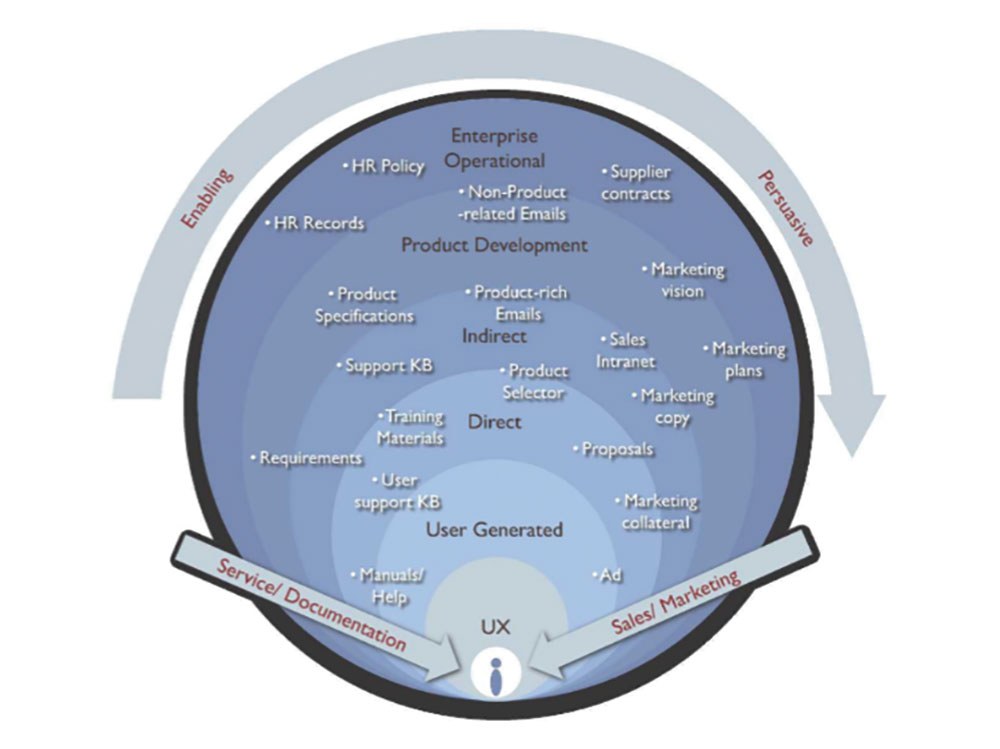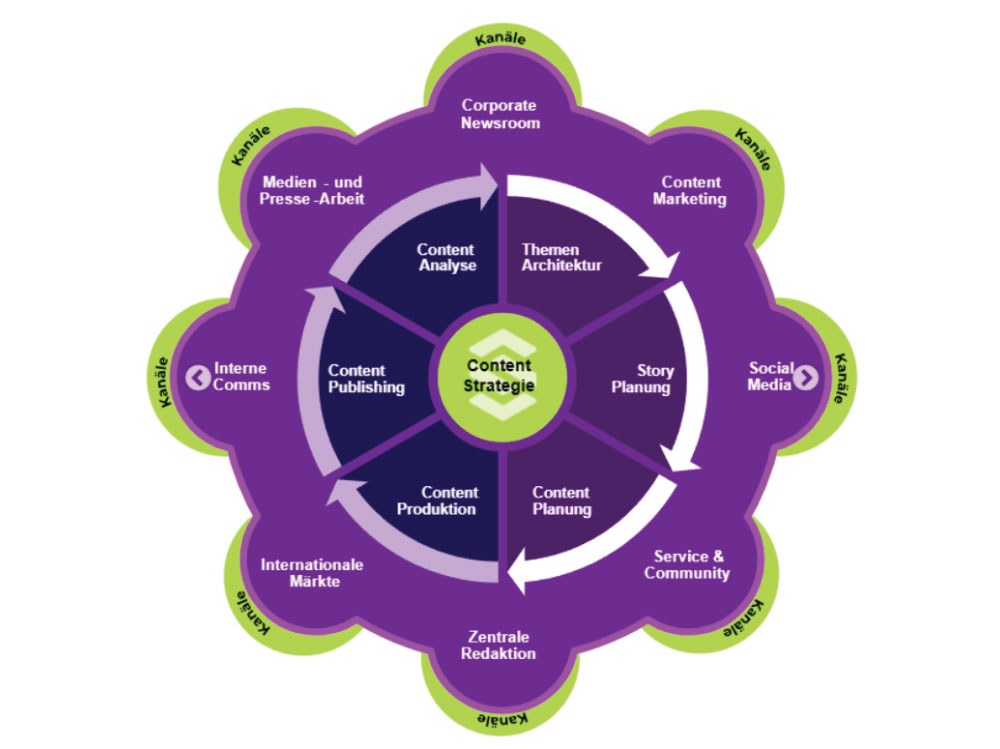The compounding cost of bad content is flying under the radar due to the lack of awareness of the role of content in business strategy in general. Content is “expensive to create, time-consuming to keep up, and impossible to do without” (Wachter-Boettcher, 2012, p. 210). At the same time, as Kristina Halvorson and Melissa Rach (2012, p. 6) wrote, “content is more or less worthless unless it does one or both of the following: supports a key business objective [and/or] fulfils your users’ needs.”
The many instances of content, as visualised in Figure 1, influence brand perception, build relationships and trust (He et al., 2021), increase customer satisfaction, and overall convey brand equity across all possible customer touchpoints.

These considerations bring us to a more practical question: How do we, as content strategists, decide what type of content should be prioritised? How do we choose which topic is best for our businesses and our users?
During Robert Weller's Editorial and Topic Planning course in the third semester of the MA in Content Strategy at FH Joanneum, we applied topic architecture to focus on this particular aspect of topic decision-making.
About Topic Architecture #
Topic architecture is the process of developing a list of topics relevant to your business and to your audience, which are then arranged into an editorial plan and systematically expressed through content. The main purpose of topic architecture is to translate the business and audience needs into editorial guidelines and processes that govern the creation of relevant and engaging content (Scompler, 2024).
Topic architecture is part of a broader content strategy and marketing framework called “SCOM”, developed by Mirko Lange, a former lecturer of the MA in Content Strategy at FH JOANNEUM (Scompler, 2022). The acronym SCOM stands for Strategic Content Marketing and is closely related to the robust Corporate Newsroom Model developed by Prof. Dr. Christoph Moss that puts transparency, credibility and customer proximity at its centre (Mediamoss, n.d.). The newsroom model highlights the need to separate topics from media, meaning content should be planned without a specific channel in mind to avoid the trap of putting the format of the content over the goal of the content. The SCOM framework is visualised in a flower-like chart (Figure 2), emphasising content strategy as the core of all editorial activities, surrounded by six stages of editorial content planning: topic architecture, story planning, content planning, content production, content publishing, and content analysis. The entire system relies on functioning management and distribution systems, which cover internal and external channels, paid, owned and earned media (Han, 2024), as well as different elements of the marketing mix: content marketing, customer support, PR, and social media marketing.

Defining Your Topic Architecture #
Topic architecture is an extension of your content strategy, which guides “the creation, delivery, and governance of useful, usable content” (Halvorson, 2018). Content strategy expresses the “why” of your work, unifying your raison d'être as a business and the problem of your target customer that you are solving. Scompler visualises the influence of content strategy on the content planning process (Figure 3) as a three-level circle:
- businesses identify topics relevant to business objectives (Themen)
- businesses use topics to guide stories
- businesses determine the specific content pieces (Beiträge) for expressing their stories

Ideally, the selected topics lie at the intersection between business-relevant areas (think of the company’s category, products, or services) and the interests of the target audience. Your relevant topics are a list of keywords that succinctly capture all the different contexts of the business and customer goals that you can address through your editorial content plan. Topic architecture is based on input from customer and market insights, such as long- and short-term business goals, stakeholder input, audience research, feedback, analytics, and consumer trends (Moustakidis, 2025). There is no one formula for collecting insights to identify relevant topics, as topic architecture tends to be business model and industry-specific. Students participating in the topic architecture lecture listed topics ideas based on their companies, such as search volume data, recent news stories, survey data, wellness trends, and competitor activity.
Here, it is essential to note that these ideas should be channel-neutral in line with the SCOM framework. The decision about the format is part of the content planning phase, where you determine the shape of your stories that best reflects your customer-oriented content strategy (Scompler, 2022). This particular process of understanding format that suits the needs of users is referred to as content design, which is defined as ”the practice of analyzing users’ information needs and habits to determine and deploy the most appropriate content types—whether that means a chart, illustration, infographic, pull quote, or copy block“ (Bloomstein, 2021, p. 51).
Prioritising Your Topic Ideas #
Admittedly, creating a list of relevant topic ideas is the easiest part of the process. Prioritising topics is the real challenge. This is where the “architecture” part comes in, where businesses can develop custom topic scoring systems that streamline the process of editorial content decision-making.
There are several options, such as assigning scores based on relevance or business alignment (Moustakidis, 2025), the effort needed to produce content (Scompler, 2024), ongoing promotional campaigns, or the expected ROI. According to Robert Weller (2021), depending on your business case, you can also consider scoring systems based on the RICE framework (Reach, Impact, Confidence, and Effort), investment/impact assessment, or search data which combines search volume and cost per click (CPC) for different topics.
Whatever option you decide on, consider your business's unique content planning and production circumstances. Your topic scoring system should reflect the reality of content production in your organisation, not a wishlist of perfect editorial processes.
Conclusion #
Topic architecture is a useful approach for applying the structured and directional approach to editorial planning, especially for teams where resources such as time, personnel, or budget are limited. By choosing to follow the gradual process of developing topics in the context of your business and customer needs, you break away from the format-oriented content production that tends to prioritise platform over content purpose. If your content strategy work centres on editorial content management, you will appreciate the straightforward approach of Scompler’s topic architecture method.
Where to go from here #
Explore more guides and articles on the subject of editorial planning on our website, including:
- The Benefits of Strategic Editorial Planning
- How to Become a Storytelling Mastermind
- Tell Me How Much You Care! The Art of Editorial and Topic Planning
References #
Bailie, R. A. (2021, February 5). An Uneven History of Content Strategy. Medium. https://rahelab.medium.com/an-uneven-history-of-content-strategy-d514cfd7eee5
Bloomstein, M. (2021). Trustworthy: How the Smartest Brands Beat Cynicism and Bridge the Trust Gap. Page Two Books, Incorporated.
Halvorson, K. (2018). New Thinking: Brain Traffic’s Content Strategy Quad - Brain Traffic blog. https://www.braintraffic.com/blog/new-thinking-brain-traffics-content-strategy-quad
Halvorson, K., & Rach, M. (2012). Content Strategy for the Web (2nd ed.). New Riders.
Han, E. (2024, February 15). Paid vs. Owned vs. Earned Media: What’s the Difference? Business Insights Blog. https://online.hbs.edu/blog/post/earned-vs-paid-media
He, A.-Z., Cai, Y., Cai, L., & Zhang, Y. (2021). Conversation, Storytelling, or Consumer Interaction and Participation? The Impact of Brand-Owned Social Media Content Marketing on Consumers’ Brand Perceptions and Attitudes. Journal of Research in Interactive Marketing, 15(3), 419–440. https://doi.org/10.1108/JRIM-08-2019-0128
Mediamoss. (n.d.). Newsroom-Modell. Mediamoss Newsroom. Retrieved 11 February 2025, from https://www.mediamoss.me/das-newsroom-modell
Moustakidis, I. (2025, January 27). A Five-Step Journey to Strategic Topic Planning. Medium. https://medium.com/@halloirismoustakidis/a-five-step-journey-to-strategic-topic-planning-27549866b5d4
Scompler. (2022, December 15). Scompler—The Content Command Center®. https://scompler.com/en/
Scompler. (2024, July 16). Von der Unternehmensstrategie zur Themenarchitektur (From Corporate Strategy to Theme Architecture). http://webinare/konzernkommunikation
Scompler. (2024, December 15). Scompler Hacks. https://scompler.com/en/content-strategie-2025/
Wachter-Boettcher, S. (2012). Content Everywhere: Strategy and Structure For Future-Ready Content. Rosenfeld Media.
Weller, R. (2021, December 2). Wie Content-Ideen Systematisch Priorisiert Werden Können (Systematically Prioritize Content Ideas – a Simple Methodology). https://www.toushenne.de/content/content-ideen-priorisieren.html
This article was based on the lecture delivered by Robert Weller on the 29th of November 2024, as part of the third-semester course Editorial and Topic Planning. The article was reviewed by Robert Weller before publication.

